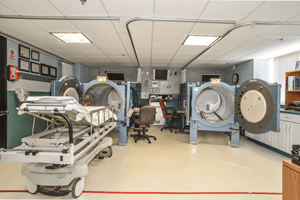
Hyperbaric oxygen therapy (HBOT) is a process in which a patient breathes 100 percent oxygen at above-normal atmospheric pressure. The process increases the delivery of oxygen to the body, enhancing the body’s natural healing process.
The Hyperbaric Manager at Kindred Hospital Kansas City has seen the positive effects of HBOT on persistent wounds firsthand.
"For those who have tried other therapies with no results, they can find great benefits with hyperbaric oxygen wound therapy," she says. It can be "life-changing," she adds, when a patient no longer has to deal with a wound that wouldn't heal and was impacting his daily life.
Kindred Hospital Kansas City’s hyperbaric oxygen unit features two state-of-the-art Sechrist 3600 hyperbaric chambers and is accredited by the Undersea and Hyperbaric Medical Society (UHMS). Certified hyperbaric technologists staff the unit.
HBOT, which is an elective procedure, is just one of many tools a wound care physician may use and it isn't used for all wounds. Patients must meet certain criteria, which vary with the type of wound, but the therapy is typically used to treat injuries to tissue or bone from radiation therapy, diabetic wounds and other wounds, including those associated with:
- compromised skin grafts and flaps
- chronic refractory osteomyelitis
- acute peripheral arterial insufficiency
- necrotizing soft tissue injury
- gas gangrene
In HBOT, the patient breathes 100 percent oxygen at an increased pressure in a specially designed chamber. As the patient breathes, the oxygen dissolves into the liquid part of the blood, the plasma. It is transported throughout the body and diffuses into the tissues surrounding the wound. This "wakes up" the cells that have not been able to function properly because of the lack of oxygen. These cells start to send out signals to generate the growth of new micro blood vessels in the wound bed. These new blood vessels are permanent and do not go away after treatments are completed. In addition, the increased oxygen supercharges the body’s own infection-fighting capabilities and enhances any antibiotic therapy that the patient is receiving.
Prior to treatment, patients tour the hyperbaric unit and learn about the therapy. During treatment, patients are typically placed in the hyperbaric chamber for a recommended 90-minute session. They are able to watch TV, sleep or chat with the hyperbaric technologist who sits outside the chamber to monitor the process. Patients will hear a soft hissing sound that may increase or decrease as the oxygen flow is adjusted for comfort, and may hear crackles and pops as the therapy ends and even briefly after it is completed. This is normal and not a cause for concern.
The Hyperbaric Manager has seen "amazing things happen" with HBOT, including a case of frostbite that had turned all of the patient's fingers black. The patient had been in an acute-care setting and came in two weeks after the initial treatment. With HBOT, "the patient regained the use of nine of his 10 fingers."
Patients must follow other medical recommendations in order for the therapy to be successful. For example, HBOT may not be successful for a diabetic patient if he or she continues smoking or doesn't follow dietary recommendations. But for patients who actively participate in their treatment and follow medical advice, HBOT has the ability to be a "life-altering" treatment that can help heal wounds that didn't respond to other therapies.